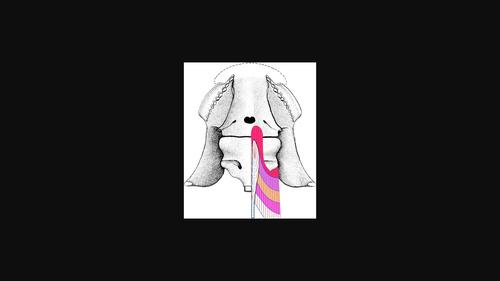当前位置:
X-MOL 学术
›
J. Morphol.
›
论文详情
Our official English website, www.x-mol.net, welcomes your feedback! (Note: you will need to create a separate account there.)
Reconstructing the subcephalic musculature in Pucapampella and Ichthyostega
Journal of Morphology ( IF 1.5 ) Pub Date : 2023-11-01 , DOI: 10.1002/jmor.21648 Alexander N Kuznetsov 1 , Nadezhda V Kryukova 2
Journal of Morphology ( IF 1.5 ) Pub Date : 2023-11-01 , DOI: 10.1002/jmor.21648 Alexander N Kuznetsov 1 , Nadezhda V Kryukova 2
Affiliation

|
We present new reconstructions of subcephalic musculature for the stem chondrichthyan Pucapampella, the tetrapodomorph fish Eusthenopteron, and the Devonian tetrapod Ichthyostega. These reconstructions are based on macroscopic dissections of the head muscles of an archaic shark Heptranchias and an archaic actinopterygian Polypterus, that are combined with functional considerations and a reappraisal of not widely known theoretical concepts from the past. The subcephalic, as well as the supracephalic, musculature is formed by four anterior myomeres. They are continuous with subsequent myomeres of the trunk, but are innervated by ventral nerve roots of the medulla oblongata and thus belong to the head. The fourth subcephalic myomere ends with its posterior myoseptum on the occiput in osteichthyans, but on the first vertebra in chondrichthyans. The original function of subcephalic and supracephalic muscles in basal gnathostomes supposedly was to hold together anterior and posterior parts of the neurocranium during interaction with prey, such as the backward-ripping prey dissection, hypothesized for Pucapampella. In sarcopterygian osteichthyans, subcephalic musculature is involved in active depression of the anterior part of the neurocranium; specialization of this mechanism resulted in a complete separation of m. subcephalicus from trunk myomeres in Latimeria. Fusion of anterior and posterior parts of the neurocranium has resulted in reduction of the subcephalic musculature in the majority of cartilaginous and bony fishes. However, hexanchid sharks retain three posterior subcephalic myomeres for backward-ripping prey dissection. Polypterus and Chauliodus have retained the subcephalic musculature, but its function has shifted to a depression of the whole neurocranium.
中文翻译:

重建 Pucapampella 和 Ichthyostega 的头下肌肉组织
我们提出了茎软骨鱼类Pucapampella、四足类鱼类Eusthenopteron和泥盆纪四足动物Ichthyostega的头下肌肉组织的新重建。这些重建基于对古老的七鳃鲨和古老的放线鳍鱼的头部肌肉的宏观解剖,结合功能考虑和对过去不广为人知的理论概念的重新评估。头下和头上的肌肉组织由四个前肌节形成。它们与躯干的后续肌节连续,但受延髓腹神经根支配,因此属于头部。第四头下肌节在骨鱼类中以其后肌隔结束于枕骨,但在软骨鱼类中则在第一椎骨上结束。据推测,基底颌口动物头下肌和头上肌的原始功能是在与猎物相互作用时将神经颅骨的前部和后部固定在一起,例如向后撕裂猎物的解剖,这是普卡潘佩拉的假设。在肌鳍骨鱼中,头下肌肉组织参与神经颅前部的主动凹陷;这种机制的专业化导致了 m 的完全分离。来自Latimeria躯干肌节的头下肌。神经颅骨前部和后部的融合导致大多数软骨鱼和骨鱼的头下肌肉组织减少。然而,六足鲨保留了三个后头下肌节,用于向后撕裂猎物。Polypterus和Chauliodus保留了头下肌肉组织,但其功能已转移到整个神经颅骨的凹陷。
更新日期:2023-11-01
中文翻译:

重建 Pucapampella 和 Ichthyostega 的头下肌肉组织
我们提出了茎软骨鱼类Pucapampella、四足类鱼类Eusthenopteron和泥盆纪四足动物Ichthyostega的头下肌肉组织的新重建。这些重建基于对古老的七鳃鲨和古老的放线鳍鱼的头部肌肉的宏观解剖,结合功能考虑和对过去不广为人知的理论概念的重新评估。头下和头上的肌肉组织由四个前肌节形成。它们与躯干的后续肌节连续,但受延髓腹神经根支配,因此属于头部。第四头下肌节在骨鱼类中以其后肌隔结束于枕骨,但在软骨鱼类中则在第一椎骨上结束。据推测,基底颌口动物头下肌和头上肌的原始功能是在与猎物相互作用时将神经颅骨的前部和后部固定在一起,例如向后撕裂猎物的解剖,这是普卡潘佩拉的假设。在肌鳍骨鱼中,头下肌肉组织参与神经颅前部的主动凹陷;这种机制的专业化导致了 m 的完全分离。来自Latimeria躯干肌节的头下肌。神经颅骨前部和后部的融合导致大多数软骨鱼和骨鱼的头下肌肉组织减少。然而,六足鲨保留了三个后头下肌节,用于向后撕裂猎物。Polypterus和Chauliodus保留了头下肌肉组织,但其功能已转移到整个神经颅骨的凹陷。



























 京公网安备 11010802027423号
京公网安备 11010802027423号